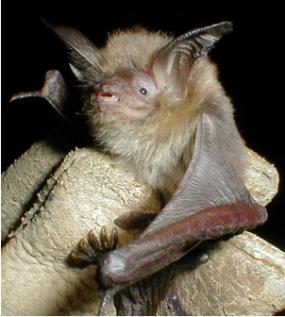Southwestern myotis facts for kids
Quick facts for kids Southwestern myotis |
|
|---|---|
 |
|
| Conservation status | |
| Scientific classification | |
 |
The southwestern myotis (Myotis auriculus) is a type of vesper bat. You can find this bat in Guatemala and Mexico. It also lives in the United States, specifically in Arizona and New Mexico.
Contents
How Scientists Classified the Southwestern Myotis
The southwestern myotis belongs to a group of animals called Chiroptera, which includes all bats. It is part of the Vespertilionidae family, known as "vesper bats."
Scientists Baker and Stains first discovered this bat in 1955. At first, they thought it was a type of bat called Myotis evotis. This was because both bats live in the same areas and have similar lifestyles.
Later that year, other scientists, Hoffmeister and Krutzsch, thought it was a new subspecies. They called it M. evotis apache. In 1959, its name was changed again to M. e. auriculus.
In 1960, a scientist named Findley realized it was not part of M. evotis at all. He thought it was a type of Myotis keenii. Finally, in 1969, scientists Genoways and Jones confirmed that M. auriculus was its own unique species.
Scientists noticed that M. auriculus has a different jaw shape than M. evotis. The southwestern myotis has a larger, weaker jaw. It also has a much bigger skull compared to M. evotis. These differences helped them realize it was a separate species.
What the Southwestern Myotis Looks Like
The southwestern myotis is generally larger than other similar bats in its home range. It has soft, brown fur. This bat also has a large skull and big brown ears. Its ears are very important for echolocation, which is how bats "see" using sound.
This bat is a nocturnal animal, meaning it is active at night. It is also an insectivore, which means it eats insects. You can find it in Guatemala, Mexico, and the southern United States. Male and female southwestern myotis bats look very similar; you cannot tell them apart just by looking. Instead of hibernating in winter, these bats move to different places.
Unique Features of the Southwestern Myotis
Several things make the southwestern myotis stand out from other bats in its group, called Myotis. This bat has bigger forearms, ears, and a larger skull. For example, its forearms are usually longer than 37 millimeters (about 1.5 inches). Its ears are larger than 19 millimeters (about 0.75 inches). Its skull is longer than 15.7 millimeters (about 0.6 inches).
Its fur patterns are also special. The southwestern myotis does not have tiny hairs on its wings or on its uropatagium (the skin between its legs and tail). Its large brown ears are also a key feature. Other similar Myotis bats often have black ears.
What the Southwestern Myotis Eats
Moths are a very important part of the southwestern myotis's diet. While they can eat other insects, they mostly eat moths. Interestingly, male bats tend to eat more moths than female bats.
Both male and female bats like to hunt about one to two hours after the sun sets. The southwestern myotis is not very picky about where it hunts. They will hunt for food both in natural areas and even inside cities.
Reproduction and Life Cycle
Southwestern myotis bats usually have their babies in June. They typically have only one baby each year. Bats living further south might have their young a bit later in the year. Scientists believe that the timing of births depends on things like the weather and food availability.
These bats live for at least 3 years and 2 months.
Where the Southwestern Myotis Lives
Since the southwestern myotis migrates, it lives in many different places. However, its favorite home is in ponderosa pine forests. These bats travel from Guatemala in the south all the way to Arizona and New Mexico in the north. Not every bat travels the entire distance.
Their migration might be influenced by things other than just temperature. However, the southwestern myotis is most active when hunting if the temperature is between 11°C and 19°C (52°F - 66°F). These bats have been found as far north as Flagstaff, Arizona, and Santa Fe, New Mexico.
How the Southwestern Myotis Behaves
In some places, the southwestern myotis lives in the same areas as M. evotis, another type of bat. When these two bats live together, their behavior changes. This is likely because they are competing for resources.
For example, in the San Mateo mountains of New Mexico, M. auriculus is more often found at lower elevations. M. evotis is found at higher elevations. This happens even though both types of bats can live in both low and high places. They seem to divide the area to avoid too much competition.
See also
 In Spanish: Myotis auriculus para niños
In Spanish: Myotis auriculus para niños


